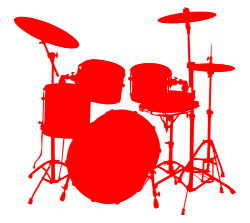In today’s lesson I’m going to show how to play jazz drums for beginners.
The Basic Jazz Pulse
The first thing for beginners to understand about jazz drumming is the basic pulse. The basic pulse is quarter notes played by an upright or electric bass. This is called a walking bass line. Since the bass player is playing this quarter note bass line, the simplest thing you can play as a drummer is quarter notes on the ride cymbal.
One thing you need to understand about jazz is that the ride cymbal is the most important element. This is different than rock music, where the snare drum and bass drum are the most important elements to the beat.
Now add a backbeat on 2 & 4 just like you would with a rock beat. But instead of playing the backbeat on the snare, play it on the high hat with your foot.This is your foundation. This works at any tempo and I’ve even heard Steve Gadd, the great studio drummer use this occasionally at very fast tempos.
Subdivisions In Jazz Drumming
The next thing to understand is the basic subdivision used in jazz drumming. In rock drumming it’s straight 8th notes. In jazz drums the basic subdivision is rounded 8th notes, more like a shuffle.
After you’ve learned to play quarter notes on the ride cymbal while playing your high hat on 2 & 4 with your foot you should learn the basic jazz ride cymbal swing rhythm using rounded 8th notes. Add your high hat on 2 & 4. Practice at different tempos.
Basic Jazz Beat For Drum-set (Swing Rhythm)
Most of the time if someone asks you to play a jazz beat that’s the rhythm they expect you to play, especially for high school or college jazz band auditions. So it’s important to be able to play that rhythm. But remember what I said earlier – the foundation is really just the quarter note pulse. So you can always revert to that when necessary.
With that in mind, next practice playing one measure of quarter notes on the ride cymbal followed by one measure of the basic jazz ride cymbal swing rhythm. Add the high hat again on 2 & 4 with your foot when you’re comfortable.
Recall what I said earlier about the basic subdivision in jazz. It’s rounded 8th notes. The next thing to practice is improvising on the ride cymbal. The quarter note is the pulse. But we’re going to throw in some of those rounded 8th notes occasionally. Again add your high hat with your foot when you’re comfortable.
Comping With Snare And Bass Drum
I mentioned earlier that in jazz drumming the ride cymbal is the most important element. And the high hat basically plays a backbeat on 2 and 4. So what is the basic role of the snare drum and bass drum? The snare and bass drum are going to play comping figures. The word comp is short for accompaniment. The snare drum and bass drum play short improvised rhythms that compliment the melody that’s being played by a horn player or some other player in the band.
Here is the next thing to practice. Recall the earlier exercise when we were practicing improvising on the ride cymbal. Add your left hand to that on the snare drum. Sometimes you can play both hands together. Other times the snare will play by itself in between ride cymbal notes. Remember that the focus is the ride cymbal so don’t play the snare drum too loud. Add your high hat on 2 & 4 when you are comfortable.

Now we’ll try the bass drum with the ride cymbal. Leave out the snare drum and the high hat for now. Again, add your high hat on 2 & 4 when you are comfortable. Remember not to play the bass drum too loud.
Ok. Now we’ll put the snare drum, ride cymbal and bass drum together. Add your high hat on 2 & 4 when you are comfortable.
Jazz Drums For Beginners – The Next Step
Now that you have learned some basic jazz drumming your next assignment is to try it with some music. Put on some headphones and try playing along with “Freddie Freeloader” by Miles Davis. Start off with just your ride cymbal and high hat. When you’re comfortable start adding a few notes on your snare and bass drum.
Good luck!






